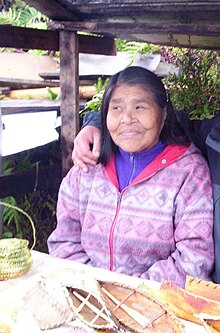Kawesqar
The people of the Kawesqar (translated 'people'), in German spelling Kaweskar (also written Kawéskar or Kawashkar , external name: Alakaluf or Alakufen , Halakwúlup ) is one of the four ethnic groups that settled in Western Patagonia until the beginning of the 20th century . Like the other indigenous people of Tierra del Fuego, they were almost completely exterminated there in the course of the invasion and settlement by Eurasian settlers at the beginning of the 20th century.
In 1985 there were still around 50 halakwúlup (according to Brockhaus from 1988). Their current number is given very differently: According to Ethnologue , it was 2,620 in 2002, and 1,800 according to the surveys of the Evangelical-fundamentalist conversion network Joshua Project . Today it is often mestizos who see themselves as Kawesqar. In 2006 there were still 22 speakers of the language (8b - nearly extinct), which was almost extinct according to SIL International .
history
The Kawesqar settled as sea nomads from the Brecknock Peninsula northwards in the water channels on the west coast of Patagonia . Originally, their settlement area extended as far as the vicinity of Puerto Montt . Individual families moved from one campsite to another in large bark canoes in search of sea lions , fish or penguins .
Of the huts built near the coast, the wooden scaffolding was left behind when moving on and so often served as accommodation for the families who followed.
Compared to the other indigenous people of the west coast of Tierra del Fuego and Patagonia, the Kawesqar came relatively early in contact with the whites who invaded their areas as fur hunters and whalers. The first European was the explorer García Jofre de Loaísa , who entered their territory in 1526. The size of the population was around 4,000 by the end of the eighteenth century. Colonization by Chile began when Fuerte Bulnes was founded on the Brunswick Peninsula in 1843 . From then on, the Kawesqar were in constant contact with the colonists. Violent clashes and infectious diseases, against which the Indians had no defenses, rapidly decimated them. At the end of the 19th century there were around 500 Kawesqar and in 1925 only 150 left. In 1940 the Chilean government passed a law to protect the Kawesqar, of whom almost no one spoke Spanish until then. The law, however, provided for forced relocation to Puerto Edén on the island of Wellington and resulted in dependence on government support and increasing assimilation . Around 1970 a bilingual education was imposed on them, so that the indigenous language is about to become extinct due to the small number of people. In 1995, many Kawesqar relocated to Puerto Natales and Punta Arenas , as the living conditions there are significantly better thanks to jobs in the fishing industry and the sale of handicrafts to tourists.
Just like the other indigenous people of Tierra del Fuego, the Kawesqar were almost completely exterminated in the course of settlement by white settlers, to which imported diseases played a decisive role. Today only a few ethnic Kawesqar people (around 50 people in 1990) still live in Puerto Edén in southern Chile.
According to the ongoing surveys of the Joshua Project, 10 percent of the Kawesqar still profess the traditional religion, while 90 percent are officially Christians.
See also
literature
- José Emperaire: Les Nomades de la Mer. Editions Gallimard, Paris 1955.
- Martin Gusinde : The Halakwulup. About the life and thinking of the water nomads at Cape Horn. Verlag St. Gabriel, Mödling near Vienna 1974. (The Tierra del Fuego Indians; Vol. 3, half-volume 1.) ISBN 3-85264-050-4 .
- Jean Raspail : They were the first - tragedy and end of the Tierra del Fuego Indians. Munich 1988. ISBN 3-548-35326-6 ( Qui se souvient des hommes ... Paris 1986.)
- Juan José Rossi : Los Alakaluf. Buenos Aires: Editorial Galerna 2007
- Christina Hofmann-Randall: The Tierra del Fuego Indians. Anthropological description of the first discoverers. In: Würzburger medical history reports 11, 1993, pp. 261–272.
Web links
- Literature about the Kawésqar in the catalog of the Ibero-American Institute in Berlin
- www.patagoniainteractiva.com (English / Spanish)
- The land of the Kawésqar (Spanish)
- "The son of Canelo (Drimys winteri - a species of tree)" A Kawésqar fairy tale (media file in Spanish)
Individual evidence
- ↑ Christina Hofmann-Randall (1993), p. 261.
- ↑ a b Ethnological information according to ISO language code 639-3: alc on ethnologue.com. SIL International , accessed February 3, 2016.
- ↑ a b Joshua Project: Chile ( Memento of the original from February 19, 2016 in the Internet Archive ) Info: The archive link was inserted automatically and has not yet been checked. Please check the original and archive link according to the instructions and then remove this notice. (Kawashkar), accessed January 18, 2016.
- ^ Native peoples> Kawashkar . In: Website of the Museo Chileno de Arte Precolombino, Santiago de Chile, accessed on February 3, 2016.


